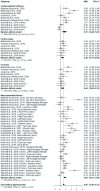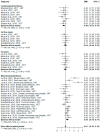Effectiveness of Whole-Body High-Intensity Interval Training on Health-Related Fitness: A Systematic Review and Meta-Analysis
- PMID: 35954911
- PMCID: PMC9367756
- DOI: 10.3390/ijerph19159559
Effectiveness of Whole-Body High-Intensity Interval Training on Health-Related Fitness: A Systematic Review and Meta-Analysis
Abstract
Due to its versatility, whole-body high-intensity interval training (WB-HIIT) can be proposed to the general population and patients to improve health-related fitness. However, its effectiveness compared to traditional aerobic continuous or interval trainings has yet to be determined. A search of four electronic databases was conducted. Studies reporting the effects of WB-HIIT on cardiorespiratory fitness (CRF), fat mass, fat-free mass, musculoskeletal fitness and metabolic risk factors were included. Standardized mean differences (SMD) between WB-HIIT and no exercise or traditional aerobic trainings were calculated. A meta-regression assessed the effect of total training time on the different outcomes. Twenty-two studies were included in the systematic review and nineteen in the meta-analysis. Compared to no exercise, WB-HIIT improves CRF (SMD: 0.75; 95%CI: 0.28, 1.23; p < 0.001), fat-free mass (SMD: 0.38; 95%CI: 0.11, 0.65; p < 0.001), fat mass (SMD: 0.40; 95%CI: 0.09, 0.72; p < 0.001) and musculoskeletal fitness (SMD: 0.84; 95%CI: 0.61, 1.08; p < 0.001). Compared to other aerobic trainings, WB-HIIT has a lower effect on CRF (SMD: −0.40; 95%CI: −0.70, −0.11; p = 0.007), a similar effect on fat-free mass (SMD: −0.04; 95%CI: −0.44, 0.35; p = 0.8) and fat mass (SMD: −0.07; 95%CI: −0.39, 0.25; p = 0.7), and a larger effect on musculoskeletal fitness (SMD: 0.42; 95%CI: 0.14, 0.71; p = 0.003). WB-HIIT overall effect and specific effect on CRF and fat mass were associated with total training time. The systematic review did not provide evidence of metabolic risk improvement. Despite a slightly lower effect on CRF, WB-HIIT is equally effective as traditional aerobic trainings to improve body composition and more effective to enhance musculoskeletal fitness, which is essential for execution of daily tasks.
Keywords: body composition; cardiorespiratory endurance; functional high-intensity training; metabolic risk factors; musculoskeletal fitness.
Conflict of interest statement
The authors declare no conflict of interest.
Figures




References
-
- Thompson W.R. Worldwide survey of fitness trends for 2020. Acsm’s Health Fit. J. 2019;23:10–18. doi: 10.1249/FIT.0000000000000526. - DOI
Publication types
MeSH terms
LinkOut - more resources
Full Text Sources

